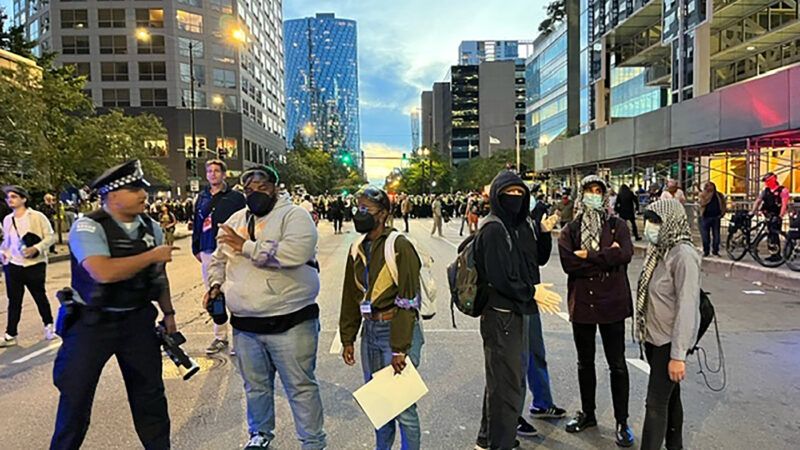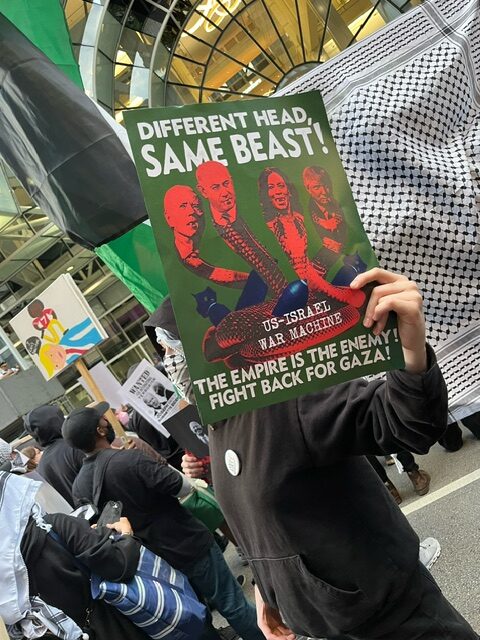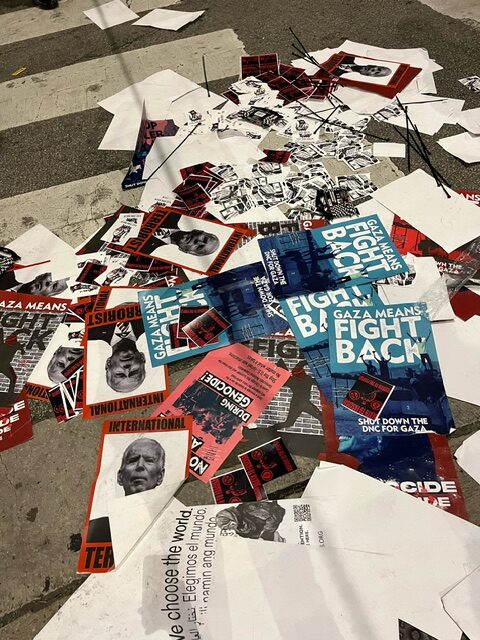An Overorchestrated Rebellion: Dispatch From the DNC
An anticlimactic protest in Chicago reveals a tired approach to modern activism.

William Langewiesche, a writer and pilot, once told me that flying a plane was "90 percent boredom, 10 percent terror." I might say the same for the "Make it great like '68! Shut down the [Democratic National Convention] for Gaza!" protest that took place in front of the Israeli consulate in downtown Chicago on Tuesday night. The event was organized by Behind Enemy Lines, and as might be expected from a group whose tagline is "The empire is the enemy. From the belly of the beast, we choose to resist it," participants arrived carrying resistance-ready banners, flags, and bullhorns.
They arrived when they said they would, 7 p.m. on the dot, after Behind Enemy Lines promoted the protest for weeks on Instagram and provided helpful links on its website. The group's leaders had also granted many pre-DNC interviews, including with me, explaining how they were real radicals, unlike the namby-pamby March on the DNC crew who'd applied for city permits—lame! If any group in Chicago was ready to let the Democrats know their imperialist and genocidal acts were being watched, and were not afraid to get into it with the cops, it was Behind Enemy Lines.

It was a message they spread perhaps too well, as the 75 or so participants were joined by maybe twice as many press people and six times as many cops. There were cops everywhere, eventually lining every curb and blocking every cross-street—a cop-a-palooza that all but assured the protest would not get out of hand, or not for very long.
This made the whole thing feel kind of staged: a clot of protesters chanting "Intifada revolution!" and "Killer Kamala, what do you say? How many kids did you kill today?" while the press all snapped the same photos (burning flag? Check). Meanwhile, more than two dozen legal observers with the National Lawyers Guild Chicago, recognizable by their fluorescent green caps, monitored police conduct and stood ready to assist any protester in need. There was a lone man waving an Israeli flag, who, at least initially, was neither approached nor harassed by the protesters.

"Is this a little boring?" asked a cameraman. An Irish journalist agreed, and the three of us—having covered more incendiary events in France, Minneapolis, and Portland, respectively—chatted about the days when protests were not announced weeks in advance, but formed spontaneously or were made known through literal samizdat or its digital equivalent. We might have gotten a little nostalgic for times when chats like this were impossible, when you were too busy ducking projectiles, avoiding a stampeding crowd, or covering your face from the tear gas.
There was none of those things here—almost none. The protesters were, if you'll excuse my vulgarity, what my late ex used to call "young, dumb, and full of cum." They were horny for confrontation, and if that meant getting in the faces of some of the cops, they'd do it. Which they did, creating a maybe three-minute scuffle during which several protesters were arrested before everybody went back to their places.

It was utterly bizarre—an overorchestrated rebellion where nothing new happened. Maybe it was our fault for paying attention. During the downtime—which was almost the whole time—I spoke with reporters from The New York Times, the New York Post, ABC, and other outlets: Had social justice protesting jumped the shark? And were those of us covering it chewing on little more than chum?
I think maybe so, and while young people protesting injustice may be evergreen, the current form has gotten tired. The protests that started in 2020 were a form of release, a way to get out of lockdown and maraud in the streets with your friends while concurrently believing you were making the world a better place. The causes could change—Black Lives Matter, Ukraine, Roe v. Wade—so long as they provided the requisite rage calories. And boy did October 7 hit so many notes—racial, historical, and religious. We would fight in the streets to prevent another Nakba or Holocaust, trusting no data unless it aligned with our values.
Michael Boyte, one of the founders of Behind Enemy Lines, told me that the Israel Defense Forces had so far murdered 168,000 Palestinians, including children by amputation. If this were true, I could understand how a protest in front of the Israeli consulate would be a "get-your-message-heard-by-any-means-possible" emergency. But it is not true, and while one might imagine an inflated number would give the protest more fire, on this night it did not. Maybe people smelled a rat. Maybe they have activism exhaustion, which turned out to be the case this past Monday, when an expected 30,000 people for a March on the DNC resulted in only 1,500 participants—an advent that can leave leaders a bit sore, even combative.

Looking around at Tuesday's participants, dressed in the usual facemasks and keffiyehs, chanting the same slogans over and over, the protest seemed like a retread, corporate rock in lieu of punk rock. No wonder they were not getting a big rush. They were settling for a simulacrum, an exercise that required little more than showing up and shouting, when they might be working in any number of ways and even quietly to end the war in Gaza.
Instead, one boy was yelling into a bullhorn two feet from cops' faces, "This is what democracy looks like!" He yelled it again and again, and I thought, yes, that is what democracy looks like: being free to be as loud and as boring as you like without fear of repercussions.
By 8 p.m., another line of police had formed to shield a very small group of pro-Israeli protesters, including one of whom carried a mounted poster of Dietrich Bonhoeffer, the German theologian executed by the Nazis, and another singing "America the Beautiful" in the direction of the pro-Palestinian protesters. As the latter began to leave, it appeared the night was over; maybe they thought it safer to slip away than risk confrontation.
The ones that stayed were not interested in safety; they were primed and revved. There had been an hour of foreplay and now it was time to mix it up. But it was an unfair fight and they knew it: about 60 young people against 600 police officers. Yet the line moved toward the cops anyway, shouting "Look at what these police are doing to us!" and "They're kettling! They're kettling!" before running alongside a line of police, some of whom gave pursuit.

Leaving the protest, I passed more lines of Chicago cops—three officers of unknown origin being pulled by bomb-sniffing dogs, and two Secret Service agents getting out of an unmarked car. It seemed like overkill. While I could understand the city not taking chances during the Democratic National Convention, most people did not want to see a return to the violence of the 1968 DNC, despite Behind Enemy Line's pitch to make it so.
Or maybe they did: On Wednesday morning, I read reports of 55 arrests, then 67, finally 72—almost every protester there. This I find striking and strange. Did the police overreact? Did the protesters want to be arrested? Are we at the stage where the conflict must be consummated to both parties' satisfaction?


Show Comments (52)